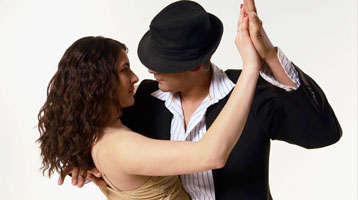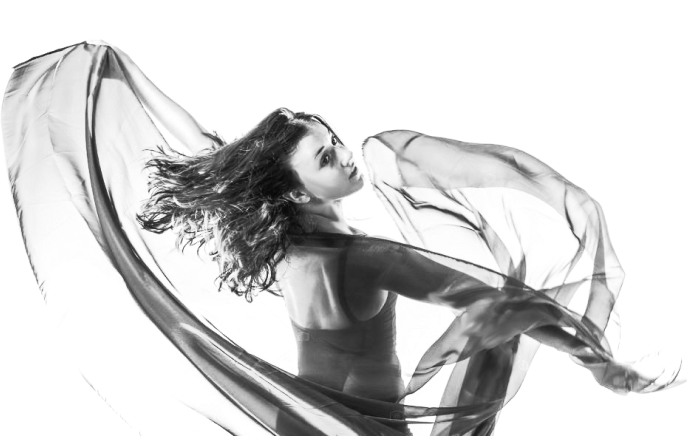
Latin Dance
Merengue
The Merengue is a vibrant Latin dance that is extremely popular in the United States and throughout the world. The Merengue is a fantastic dance for new dancers because it is very easy to learn! The Merengue is danced with “walking steps” with a step taken on each beat of music. While dancers typically use hip motions with this dance, the amount of hip movement varies with personal preference. This dance is considered to be in the same “family” as Salsa and is popular in the night club and social dance scenes.
History of the Merengue
The Merengue is a Latin dance that developed in the Caribbean during the 1800s. The history of Merengue’s origins is often debated, but there are two prevalent stories about how Merengue got its start. In one story, a local hero in the Dominican Republic was wounded in the leg during the revolutions. Villagers welcomed him home with a victory celebration and out of respect and sympathy everyone dragged one foot and danced with a limp. Some say this war hero was a pirate with a wooden right leg who danced on the Dominican beaches and the rest of the nation’s population later emulated his style. The second story claims that Merengue dancing originated with slaves who were chained together and were forced to drag one leg as they cut sugar to the beating of drums.
The word “Merengue” is very similar to the spelling and sound of the word given to the sweet pastry “Meringue.” It is believed that the Merengue dance may have gotten its name from the dessert made of egg whites and sugar because of the dances light and frothy character and because of the short, precise and rhythmical steps of the dance.
Merengue is considered the Dominican Republic’s national dance. It is a fusion of European and African cultures, which is not surprising considering the history of the Dominican Republic. In 1697, Spain gave up one third of Hispaniola Island to the French. This was called St. Dominque and later became part of what we know as the Dominican Republic. In 1790, the French had about 500,000 African slaves being controlled by only 57,000 white men and colonists. In 1791, some of the slaves fought back and slaughtered numerous Frenchmen causing many Frenchmen to flee to Cuba with their slaves. Haiti ruled over St. Dominque until 1844 when it was named the Dominican Republic. The nation went through many dictatorships before the United States intervened with a democracy in 1965. Through this lineage of different populations ruling and occupying the Dominican Republic, it makes sense that the nation’s dance Merengue would reflect both European and African influences. The Merengue dance was originally strongly influenced by the European contra dances and evolved to adapt to the islands’ inherited Afro-Caribbean rhythms.
From the start, Merengue dancing became very popular. It was easily accessible due to its simple and open nature. Originally, partners had the freedom to hold hands throughout the dance or separate while maintaining close contact. Dancers were able to add steps and their own individualistic dance style.
The Merengue was first introduced to the United States in New York in the 1930s. It wasn’t until several years later that the dance became well known to North American audiences. Today, Merengue is a very popular dance throughout the world. It’s most known for it’s lively music and fun dance moves.
Merengue Dance Today
Today, Merengue dancing is celebrated throughout the world. It is often featured in Latin dance clubs alongside Salsa and other Latin dance favorites, like Cha Cha, Bachata and Cumbia.
Authentic Merengue is danced to a clear and consistent rhythm. The dance is casual and when turns are used they are done to walking steps in as many steps as the dancer sees fit. This is very different than Merengues’ “dance sister” Salsa, which uses fast spins given on exact steps and completed with specific timing. Authentic Merengue dance styling is simple and there is no need for the exaggerated Latin vertical back and forth hip action. When dancers of Folk Merengue do move their hips, they move them in full circles while maintaining a straight upper body. Authentic Merengue dance follows the feel of the music and emphasizes improvisation, mood, and the partnership itself. This folkloric style of Merengue is still danced in the rural parts of the Dominican Republic.
You can find Merengue dance in the Ballroom dancing world. It’s regulated with more rules and specific styling than the “authentic style” of Merengue. Cuban hip action is an integral part of all Latin Ballroom dances and Merengue is no exception. Ballroom dancers focus on posture and typically give reasonable distance between a dancing duo when in dance frame. Movements are slow and majestic.
Today, nightclub Merengue is probably the most popular. It’s similar to authentic Merengue in its casual feel, but incorporates more complex arm moves and wraps. The pretzel-like arm patterns from Salsa and Swing are often borrowed and done in Merengue with relaxed timing. Nightclub Merengue is danced both in open frame and more intimate closed dance holds. Nightclub dancers aren’t hesitant to throw in dips within their Merengue dancing to dazzle and spice up the dance.
Regardless of which style of Merengue is chosen, the dance is fun, lively, and accessible to everyone. It will continue to survive and soar in the dance world with its rich cultural history, upbeat nature, stress-free movements, and cheerful music.
Merengue Music
- “On The Floor” Jennifer Lopez ft. Pitbull
- “La Negra Tiene Tumbao” Celia Cruz
- “Suavemente” Elvis Crespo
- “Don’t Stop The Music” Rihanna
- “La Morena” Los Sabrosos
- “Ojos Asi” Shakira
- “You’re the One” Paul Simon
- “Hot, Hot, Hot” Buxter Poindexter
- “El Poder De Las Mujeres” Yvonne
- “Es Mentiroso” Olga Tanon
- “Abusadora” Wilfrido Vargas
- “El Rey Del Mambo” La Banda Gorda”
- “Sshh!” (Merengue Version) Kumbia Kings
- “No Me Digas Que No” La Makina
- “Ahora” Fulanito
- “Con Agua y Jambon” Los Hermanos
- “El Jardinero” Wilfrido Vargas
- “Colegiala” Alex Bueno
- “Oye Abre Tus Ojos” July Mateo Rasputin
- “La Dueña del Swing” Los Hermanos Rosario
- “Danza Kuduro” Don Omar ft. Lucenzo
- “Suave” Mayer ft. Pitbull &Mohombi
- “Adrenalina” Wisin ft. Jennifer Lopez & Ricky Martin
- “Sufriendo por Ella” Zafra Negra
- “Ahora” Fulanito
- “Me Miras y Te Miro” Groupo Mania


